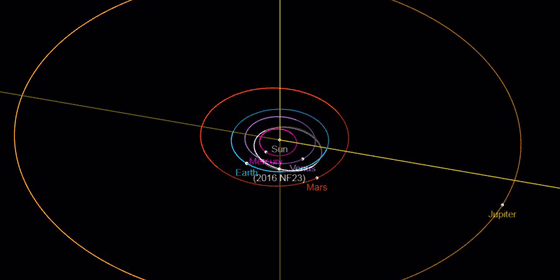A colossal asteroid that NASA labels “potentially hazardous” is headed toward Earth, but not to worry. Despite a spate of recent articles describing a fast-moving, pyramid-sized space rock that will "skim" or "hurtle close" by Earth on Aug. 29, asteroid 2016 NF23 poses no immediate threat to our planet.
"There is zero chance of this asteroid impacting Earth for the foreseeable future" Lindley Johnson, NASA's planetary defense officer, told NBC News MACH in an email. "We don’t know why someone in the media has chosen to sensationalize a relatively mundane pass of this object."
At its closest approach, the asteroid will be 13.14 times the distance from Earth to the moon, or about 3.1 million miles, according to NASA. The space agency estimates that the space rock has a diameter of 70 to 160 meters (230 feet to 525 feet), or "roughly the size of an American football field," according to Johnson. It's moving at about 20,000 miles per hour.
Johnson said asteroids of this size pass within a few million miles of Earth "at least weekly."
2016 NF23 could "wander" closer to Earth on a subsequent orbit, Johnson said. But simulations of the asteroid's orbit over the next two centuries found nothing to worry about.
Somewhere out there, of course, there may be a big asteroid with our number on it. But if there is, we haven't found it.
"There are no asteroids that we know of right now that have a very high chance of hitting Earth in the next 100 years," former astronaut Ed Lu, co-founder of the B612 Foundation, a Mill Valley, California-based nonprofit that promotes planetary self-defense, told MACH this year. "However, there are many asteroids we have simply not yet tracked, so we can't say anything yet about those.
An asteroid known as 2009 FD is considered the likeliest space rock of significant size to be on a collision course with Earth, Johnson said. The 520-foot-wide object has a one in 710 chance of striking our planet — on March 29, 2185.
By then, we may have found a way to eliminate the threat. According to a report released in June by the White House Office of Science & Technology, NASA has been asked to come up with new ways to deflect an asteroid heading toward Earth including "rapid-response" missions in which a spacecraft could somehow change the course of the space rock.

